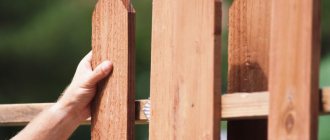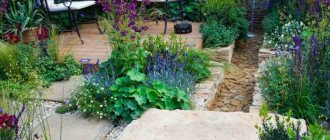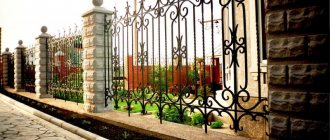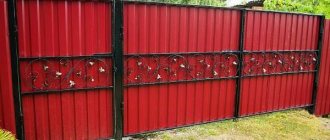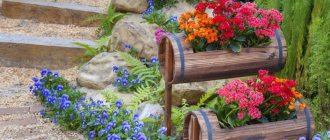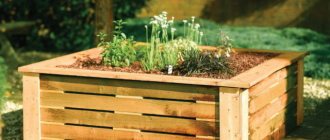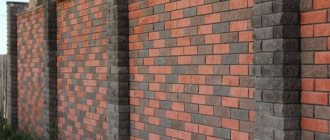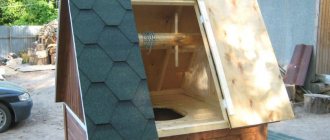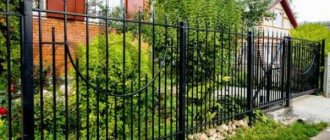A free plot of land in front of the house is an excellent opportunity to turn it into a blooming oasis. A front garden fence will help preserve the integrity of plants or highlight the beauty of nature. There are many materials for making fences, as well as structural forms. The characteristics of each type will help you choose the right fencing for your own flower garden.
The purpose of the fence for the front garden
When planning to make a fence for the front garden, attention is paid to two main aspects: the properties of the material and the shape of the structure. The choice depends on the assigned functions, whether it will be a purely decorative element or the fence is intended for protection. Often, flower garden fencing performs several tasks simultaneously.
A palisade fence that matches the main fence or building will help achieve a harmonious landscape design. If the fence of the entire area is made of corrugated board, it would be logical to install a miniature fence around the flower bed made of a similar material. The presence of a tree in the design of a house or fencing a common area brings wooden fences for the front garden to the fore. Despite the variety of types of fences, forged front gardens are characterized by the greatest practicality in combination with decorativeness.
When choosing a particular design, the priority functions assigned to the fence are taken into account. Will it be:
- protecting the front garden from pets;
- a fence as an element of zoning the territory of a site;
- support for climbing plants;
- purely decorative element.
Beautiful fences, including wrought-iron front gardens, are pictured below:
Tips and tricks from experienced builders
We bring to your attention time-tested advice from experts in their field:
- Do not rush to plant flowers until you have completed all the work on installing the fence;
- To ensure harmony reigns in your exterior, consider the material, shape, size and color of the fence;
- Involve children in work so that they learn to value things and work;
- Decorate the path in the front garden with a forged fence;
- Install a gate if the fence is higher than 80cm;
- When thinking about the design of a fence, it is better to leave everything in the hands of professionals. The drawing is developed in 3D format and an experienced master will cope with this task better and faster;
- Don't go overboard with the fence decorations;
- If the fence is not massive, then it is enough to concrete only the space for the support posts.
As you can see, not such colossal efforts are needed to erect a wrought iron fence. Many non-professionals and simple enthusiasts can do this. Although at first it may seem that you cannot master this difficult material. If your imagination temporarily does not give you any ideas, then photographs on specialized sites will help you cope with this difficulty and come up with an original composition of flowers and metal.
Characteristics of materials for fencing the front garden
When choosing material for fencing a flower garden, they are guided by the following criteria:
- performance properties;
- aesthetics;
- fencing cost;
- ease of installation;
- ease of care.
At the same time, do not forget about the harmonious combination with other elements of the site. The fence for the front garden can be made of the following materials:
- Metal. Characterized by extreme practicality. Depending on the chosen category of metal, the price range is quite wide. For a budget fencing option, a chain-link mesh is suitable, while a forged structure will create an atmosphere of aristocracy and sophistication. Strength and durability are the key advantages of metal fences. To avoid rust, choose a material with an anti-corrosion coating or treat the surface yourself with protective agents.
- Tree. Among the advantages of the material are simple installation and the possibility of further replacement of failed elements. A creative approach to the painting process can give a fence a whimsical or sophisticated appearance. The affordable price is another plus of wooden fencing. Attention! Natural material is unstable to aggressive environmental factors. The appearance of fungus and mold, destruction under the influence of moisture are the main problems of wooden fences. Therefore, a wooden front garden fence needs regular protection.
- Plastic. A relatively new material that is used to make fences. Cheapness and resistance to moisture are attractive features for a front garden fence. It is used mainly for decorative purposes. You should be prepared for color loss when exposed to the sun's rays.
- Stone. Natural material is valued for its durability and aesthetics. You can decorate your front garden with a fence made of stones yourself. The difficulty is the transportation process and installation time. High cost is the main obstacle to the widespread use of stone as a fence for the front garden. Moreover, to perform the protective function it will be necessary to combine it with a metal fence.
- Concrete and brick. They have sufficient resistance to precipitation, but the materials are less aesthetically pleasing compared to natural stone. The process of creating a fence is quite labor-intensive; the amount of work largely depends on the height of the structure. Fencing a front garden made of brick or concrete is used if there is leftover material after the main construction.
- Recyclable materials. The most democratic option for fencing a flower garden. The range of materials is unlimited. Car tires, plastic bottles, clay pots or plates - it all depends on the imagination of the owner of the front garden. Lack of material costs and ease of installation are the main advantages of available tools. In addition, they are all resistant to negative external factors.
Classic and non-trivial solutions for fences for the front garden are presented in the photo gallery:
Stage 3 – Construction
Building a front garden with your own hands is within the power of every person. However, it is worth considering that a forged fence has quite an impressive weight, this can cause a lengthy installation. Therefore, if forged fencing is too heavy, you will have to add a construction hoist to your arsenal of usual tools. In the case where the soils on the site are prone to movement, it would be advisable to lay a foundation.
Construction of a foundation and pillars for a wrought-iron front garden
Next, everything is poured with concrete mortar and allowed to dry for about a week in hot, dry weather. If it is not planned to build a foundation, forged elements of fences are planted in the ground, or rather not the prefabricated structures themselves, but support pillars that hold the load. When the foundation is ready, support pillars are installed (with your own hands or with the help of specialists) on which the fences will be attached.
They can either be immersed in the foundation or mounted separately.
Decor and design of wrought iron fence
When the soil is ready and all the necessary manipulations with the plants have been done, all that remains is to secure the forged fences in front of the house.
It’s not difficult to do the installation yourself; just attach the individual elements with special fasteners and the front garden is ready. In some cases, the structure is welded to support pillars. This way the metal will have better adhesion, and the fence itself will last longer.
Attaching a forged fence section to brick pillars
Variety of metal structures
The beauty and environmental friendliness of wood is undeniable, but from a practical point of view, a metal fence for the front garden wins. Forged fences successfully combine high performance properties with decorative properties. The variety of metal structures is represented by the following types of fencing:
- Forged Products;
- fences made of corrugated sheets;
- metal picket fence;
- lattice fences.
Forged fences
Front gardens decorated with wrought iron fences are extremely elegant. Stamped fencing elements are presented in specialized stores; an individual order from a craftsman will help you become the owner of an exclusive fence. Depending on the height of the fence, it can serve a purely decorative function or become a reliable protection for the front garden from animals.
The cost of the fence depends on the complexity and number of forged elements. The installation of a forged structure is preceded by a preparatory stage in the form of pouring the foundation and installing support pillars.
Attention! The significant weight of the forged elements forces the use of assistants and lifting equipment in the design of the fence; it will not be possible to complete the work yourself.
When the foundation with supporting pillars gains strength, they proceed to installing forged sections for fencing the front garden. At this stage, special equipment and welding skills will be required. After the process is completed, the welding seams are cleaned and sanded, the surface of the forged fence is degreased and treated with an anti-corrosion compound. At the final stage, the forged fence is painted.
Wrought iron fences are valued for the opportunity to admire the beauty of the front garden without losing practical functions. Photos will help you enjoy the beauty of forged fences:
Rabitz
Chain-link mesh has become widespread when fencing front gardens. Installation of the fence also requires the installation of metal support posts. It is preferable to install sections by welding. A wire stretched between the cells and connected to a support will help maintain the shape of the grid without a frame. The front garden, where the chain-link mesh is decorated with metal corners, is more attractive.
Comment! Such a fence can easily be converted into a hedge by planting climbing plants along the structure.
When choosing a chain-link mesh, give preference to a product with a galvanized coating, which will prevent the development of rust and increase the service life of the structure as a flower garden fencing.
Both perennial climbing plants and annuals can decorate a front garden with a chain-link fence. Popular:
- girl's grapes;
- various varieties of clematis;
- wood plier;
- sweet pea;
- morning glory.
Corrugated fences
The metal picket fence is identical to the wooden structure. The function of support pillars is performed by pipes. Between them there are horizontal metal elements onto which sheets of corrugated sheets or individual strips are fixed. When using separate strips, the consumption of fastening material increases significantly.
The attractiveness of a front garden with a fence made of corrugated board will increase if you choose multi-colored elements or an imitation of the texture of stone.
Three front garden design options
A front garden made of corrugated sheets can be:
- continuous,
- combined,
- with decorative inserts.
A solid fence is the most common. As a rule, the height of such a fence is 2–2.5 meters - this is enough to close the area from the eyes of passers-by and make it very difficult to penetrate it. But to fence miniature front gardens in the private sector of large cities, low solid fences up to one meter in height are often made. This is due to the minimum area of the site in front of the house - a standard solid fence will shade it almost all the time.
Solid low fence for the front garden
If you need more light, you can make a front garden from a metal profile and a forged lattice. The lower half of such a combined fence is usually covered with corrugated sheets, and the upper half is made forged. This design option is especially popular in villages: the lattice allows light to freely penetrate into the area in front of the house, and the corrugated sheet prevents the entry of dogs, chickens and other animals.
Previous NextCombined fencing for the area in front of the house
The third design option is a corrugated sheet as decorative inserts. Typically, corrugated sheeting is combined with forged elements, but Euro picket fence, stone, brick and other materials can be used. A special case of a combined fence is an insert of corrugated board in a wrought-iron fence at eye level. On the one hand, such a fence is almost completely translucent. On the other hand, the front garden turns out to be more or less protected from prying eyes.
Previous NextFences near the house with decorative inserts made of corrugated sheets
Front garden made of Euro picket fence
Euro picket fence is a complete analogue of the classic wooden picket fence, but with all the advantages of corrugated board.
An ideal material for front gardens in cottage villages and urban areas. Top ↑
Types of wooden fence
Wooden fences for the front garden are designed to maintain closeness to nature. Despite the low practicality of wood as a fence, it is still popular due to its aesthetic appearance and variety of designs.
Fence
Due to the ease of creation, the picket fence has become widespread. Short boards are the main element of a wooden fence. A non-trivial approach to painting the fence helps to add individuality to the front garden. They are also experimenting with the height of individual fencing elements: the planks can be the same length or form a fence with wavy outlines. The principle of creation is similar to a metal picket fence:
- Initially, the installation of support columns is underway;
- then horizontal strips are attached;
- Finally, the vertical planks are fixed.
Advice! The distance between the support posts is chosen to be small to give the front garden fence stability. Otherwise, the sections may collapse from a strong gust of wind.
A lattice structure is more difficult to manufacture when the fence boards are installed diagonally and intersect each other. When choosing a fence for the front garden, you should remember that thin planks look more elegant and attractive, and flowers need gaps in the fence of sufficient width to allow sunlight to enter.
timber
A front garden fencing made of timber looks somewhat massive and is used less frequently than a classic picket fence. The reason is the complexity and high cost of the idea. Experience in wood carving allows you to create real masterpieces with figured columns or intricate patterns.
A timber fence looks most harmonious in combination with a log house. In addition to timber, birch poles or exotic bamboo are used to create a front garden fence. The choice depends on the overall architectural concept and stylistic orientation of the landscape design.
Wattle
The fence will allow you to plunge into the atmosphere of a village of the last century. The basis of the front garden fence is:
- willow twigs;
- hazel;
- vine;
- young shoots of cherry or apple trees.
Advice! To make the material flexible, it is soaked in water for a day.
Experienced craftsmen perform elegant openwork weaving when decorating the front garden fence. Examples of various wooden fences for the front garden are shown in the photo gallery:
Buy or make it yourself?
There are three options for how you can proceed.
In the first case, a specialist will arrive who will draw up an estimate, make a drawing and buy all the materials for you, after which he will carry out the assembly. This is the most expensive of all methods, but in some cases it is indispensable if we are talking about combining brick supports and a decorative picket fence.
In the second case, if you decide to make, for example, a fence from a metal picket fence, you will have to do the calculations yourself, acquire your own tools, and purchase ready-made materials in the store. Assembly, as a rule, with a simple structure and ready-made supports, takes one or two days.
In the latter case, you buy blanks and form a fence from them. There is no need to count on the fact that you will get a fence equal to the factory one. But for a summer cottage it will do just fine.
Other types of fencing
In addition to traditional wood and metal, other types of fencing are also used when creating a fence for the front garden.
A natural stone
A fence made of natural stone can compete in expressiveness with a forged structure. Stonework looks impressive and laconic. The stones are connected to each other with cement mortar. Such front garden fencing fits harmoniously into various styles of landscape design.
Relatively recently, a new type of fencing has appeared that uses stones - gabions. The design is a durable mesh frame filled with stones. The massiveness and high cost of the fence is the main reason for its limited use as a fence for the front garden.
Painting a stone fence with luminescent paints can add exclusivity to a landscape design. Such a fence will emit a muted glow in the evening. The following types of natural stone are used as front garden fencing:
- tuff;
- sandstone;
- limestone;
- slate;
- granite.
Concrete and brick
The front garden fence made of ready-made concrete panels combines practicality and decorativeness. But the massiveness of the structure creates difficulties during transportation, unloading and installation. It is impossible to cope with such a fence alone.
Fewer problems arise when designing a brick fence for the front garden. But building a fence requires skills in working with brickwork.
Advice! Decorating a front garden with a brick fence requires pre-treatment of the material with special compounds that prevent the appearance of efflorescence on the surface of the fence. In the absence of protective measures, the brick absorbs salts from the soil, which subsequently appear on the surface of the fence and spoil its appearance.
Fencing a front garden with concrete or brick structures requires preliminary preparation of the foundation.
Plastic and other recyclables
The high performance characteristics of plastic were the reason for using the material as a fence for the front garden. Light weight and easy installation, a variety of colors and shapes are attractive features of plastic fencing. Installation does not require additional labor.
The means at hand will help you save your budget when decorating a fence. Car tires painted in bright colors or plastic bottles play an exclusively decorative role. There is no need to talk about protective functions here.
Painting and decoration
A decorative front garden with forging, made at an industrial enterprise or in a private workshop, is most often already finished with metal paint, spray coating or polymers. This product does not require additional finishing or painting. When installing sections, you just need to be careful not to impact the surfaces of the parts.
When making it yourself, the front garden (forged or bent) must be protected from corrosion. To do this, remove scale from all surfaces that were heated to high temperatures (during forging and welding). Then they are treated with exterior paint intended for metal products (oil-based, nitro-enamel, car painting sprays, latex or polymer compounds, etc.). You can choose colored or metallic paints like bronze, etc.
For forged fences, when painted independently, a method of finishing with silvering or gilding (metallic spray) is often used on the ends of decoratively curved pattern elements, rosettes, finials, etc.
Choosing a style for the front garden
Creating a beautiful and unique front garden yourself on a personal plot is not so difficult. The main thing is to choose a style and plants suitable for it. With the help of a front garden on the site you can do:
- Rabatku is an excellent solution for rectangular plots that are located between the house and the fence. Rabatka involves planting plants in strict rows;
- Mixborder is one of the popular types of flower gardens. A complex ensemble of various types of ornamental plants of the deciduous and flowering variety;
- Rock garden is a plant composition that imitates a mountain landscape. When creating a rock garden, you need to plan everything so that the slide looks harmonious and impressive;
- Border is an area with ornamental and other plants planted along paths.
The style of the front garden is selected based on the size of the allocated area. If the plot and the house are made in a classic style, then you should not create a front garden with a complex composition and exotic plant species. It is better to plant bright plants with beautiful flowering and do it in the usual style.
Highlights several of the most popular styles:
- Rustic;
- Classical;
- Asiatic;
- Mediterranean.
In the classical style, it is customary to select one plant and make it the main one, and create the rest of the composition around it. Rustic or Country style implies sloppiness, while Asian style requires restraint and multi-tieredness. In the Mediterranean style, plants should be grown in pots or tubs that can be moved to another location if needed. The main thing in landscape design is the harmonious design of the front garden and other elements on the site.
Round shapes and warm colors
As you walk along the gravel path leading to the house, you are immediately struck by the spectacular globe hollies (Ilex) 'Convexa', which remain decorative all year round. To maintain their shape, they need to be cut in the spring before the shoots appear and again in August. At the “feet” of the tree beauties, geranium (Geranium) 'White Ness', which blooms in June, and white foxglove (Digitalis) 'Alba', which colors the space until July, are planted.
Chaenomeles in the background of the front garden display salmon-colored flowers in early spring. Round shapes and warm colors
Raised flower beds with Corten steel retaining walls feature roses 'Schneeflocke' and the herbaceous perennials Geum 'Red Wings' and chrysogonum that bloom from June to August. They are harmoniously complemented by decorative leaf heuchera 'Tiramisu' and sedge (Carex remota). A white acacia (Robinia) 'Umbraculifera' with a spherical crown and paniculate hydrangea create a cozy atmosphere near the striking red bench in the right corner.
Advice : when selecting green “pets”, first of all pay attention to “long-lasting” species with an expressive “appearance”.
So, it is better to plant a long-blooming, hardy rose (for example, the 'Schneeflocke' variety) in the front garden than a profusely but once-blooming beauty. Among the herbaceous perennials, it is worth highlighting eremurus and foxglove with long candle-shaped inflorescences, hostas with leaves of various colors, as well as ornamental grasses that give the composition lightness and airiness. Metal front garden in front of the house photo? In spring, flower beds can be supplemented with bright bulbous plants. You should not deny “registration” to shrubs and trees. In crowded but not mad!
Flowering turf, crown mock orange or sycamore maple 'Globosum' with a spherical crown will fit perfectly into a friendly company. You can place containers with summer leaves near the door to the house - they will serve as additional bright accents.
Left : The pots by the front door involuntarily attract the eye. In them (pictured) decorative leafy herbaceous perennials grow: hosta 'Sun Power' with yellow leaves, variegated 'Fortunei Aureomarginata' and 'Francee', related shieldweed and heuchera 'Red Fury'.
Right : at first glance, the perfection of their forms captivates two sycamore maple trees (Acer platanoides) 'Globosum' with spherical crowns, a group of boxwoods of the same shape and a neatly trimmed low hedge that stretches along a semicircular path.
Left: hostas, shieldweed and heuchera. Right: Sycamore maples and boxwoods
A wrought iron fence looks very impressive and gives the front garden a romantic look. The color and design of such a fence can be very different, the main thing is that the element fits into the overall style of the garden.
A wrought iron fence looks very impressive and gives the front garden a romantic look. The color and design of such a fence can be very different, the main thing is that the element fits into the overall style of the garden
The path to the house should be straight and of such width that two people can easily pass on it. Suitable coatings include paving stones, clinker, gravel or concrete slabs. If you put trash cans in the neighborhood, they can be hidden behind a picturesque bush or a beautiful screen.
A hedge or fence made of wood (or metal) should be low so that nothing interferes with admiring the flower beds.
Left : The path, laid alternately with gravel and rectangular slabs of natural stone, looks like a work of art and at the same time complements the white-flowered cousa (Cornus kousa) 'Venus'.
Left: gravel and natural stone path. Right: cobblestone path bordered by boxwood hedges
Right : The cobblestone path, framed by a low boxwood hedge, has a rustic charm. In the flower garden, the territory is divided by spherical boxwoods and herbaceous perennials - geranium and lily of the valley loosestrife.
